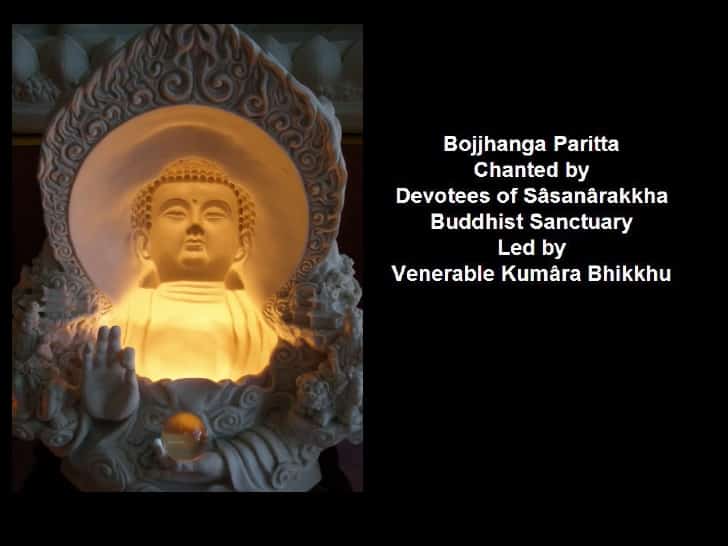Bojjhanga (Pali: satta bojjhaṅgā or satta sambojjhaṅgā; Skt.: sapta bodhyanga) are the seven qualities that both lead to Enlightenment and also describe Enlightenment. The Buddha referred to these factors in several of his sermons recorded in the Pali Tripitaka. In the Sutta Pitaka’s Samyutta Nikaya, the bojjhangas refer to wholesome, mundane factors leading to Enlightenment. In the Abhidhamma and Pali commentaries, the bojjhangas tend to refer to supramundane factors concurrent with Enlightenment.
The Pali word bojjhanga is a compound of two words, bodhi (usually translated as “Enlightenment”), which is an abstract noun formed from the verbal root ”budh”- (to awake, become aware, to notice, know or understand) corresponding to the verbs bujjhati (Pāli) and bodhati or budhyate (Sanskrit)), and anga (“factors”, ”limbs”, ”a part of a whole”, ”cause”). Bodhi also denotes the insight concerned with the realization of the Four Noble Truths. Therefore, bojjhanga means the factors of enlightenment or the factors for insight, the wisdom which conduce to Enlightenment.
Buddhism is the teaching of Enlightenment. One who is keen on attaining it should know clearly the impediments that block the Path, meaning the ”Five Hindrances”: sensual pleasure, ill-will, sloth-torpor, restlessness-worry, doubt, and the nutriments of these hindrances: the three evil modes of life – bodily, vocal and mental wrong-doing. They may be attained by means of the 4 foundations of mindfulness (satipatthāna).
In Buddhism, the Seven Factors of Enlightenment are:
– Mindfulness (sati). Means to remember to watch the mind’s movement, to remember the Dhamma. It is the instrument most efficacious in self-mastery, and whosoever practices it has found the Path to deliverance. It is fourfold: contemplation of the body, feeling, mind and mental objects (or mind concepts).
– Investigation of the law (dhamma) of how the mental states arise. It is the sharp analytical knowledge of understanding the true nature of all constituent things, animate or inanimate, human or divine. It is seeing the things as they are, in their proper perspective and into their fundamental elements. The word dhamma is taken by most translators to stand for the Buddhist doctrine, but it refers also to the bodily and mental phenomena (nāma-rūpa-dhammā) as presented to the investigating mind by mindfulness, the 1st factor. With that interpretation, the term may be rendered by ‘investigation of phenomena’.
– Energy (viriya), it is a mental property (cetasika) and the sixth limb of the Noble Eightfold Path, the Right Effort. The function of virya or energy is fourfold. It is defined as 1. The effort to eradicate evils that have arisen in the mind; 2. The effort to prevent the arising of unarisen evil; 3. The effort to develop unarisen good; and 4. The effort to promote the further growth of good already arisen.
– Rapture (pīti) or happiness. This too is a mental property and is a quality which suffuses both the body and mind. The man lacking in this quality cannot proceed along the Path to Enlightenment.
– Tranquility (passaddhi), relaxation of both body and mind. Passaddhi is twofold. Kaya passaddhi is calm of the body. Kaya means all the mental properties rather than the physical body; in other words, the calm of the aggregates of feeling, perception and volitional activities. Cittapassaddhi is the calm of the mind; that is, the aggregates of consciousness.
– Concentration (samādhi), the collected state that stays on the object of meditation, a calm, one-pointed state of concentration of mind. It is only the tranquilized mind that can easily concentrate on a subject of meditation. The calm, concentrated mind sees things as they really are. The unified mind brings the five hindrances under subjugation.
– Equanimity (upekkhā). Seeing arising-passing away of objects with a calm and tranquil mind without disturbance, with dispassion and detachment. In the Abhidhamma, upekka is indicated by the term neutrality. It is a mental equipoise (and not indifference). Equanimity is the result of a calm and concentrated mind.
There are Fixed factors and Variable factors. Fixed factors are completely wholesome factors of mind and can never be found in unwholesome states. They are always positive no matter how much of them is present.
Variable factors like energy, joy, investigation, and tranquility can be found in unwholesome states and sometimes are wholesome and sometimes mixed with unwholesome. These are the factors which must be balanced.
If these seven factors have been [fully] developed then this is called being well developed in the factors of enlightenment.
According to the Samyutta Nikaya, once when The Buddha was gravely ill he asked Venerable Mahacunda to recite the seven Factors of Enlightenment to him. In such a way The Buddha was cured of his illness.
Those whose minds, rightly, are well developed in the factors of enlightenment, who delight in relinquishing acquisitiveness and non-attachment, they in this world are ones who are illuminated [with wisdom], have eliminated the [mental] effluents and completely extinguished [the fires of greed, hatred, and delusion].
Photo credit: alternativa




